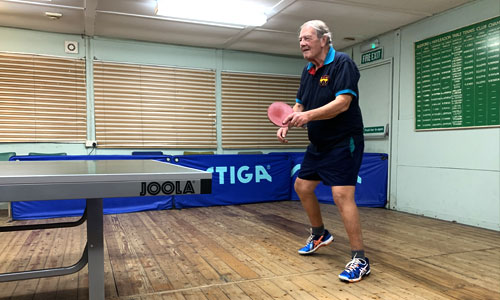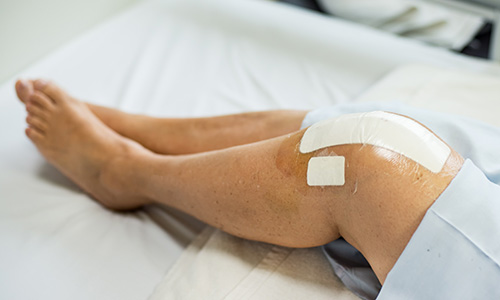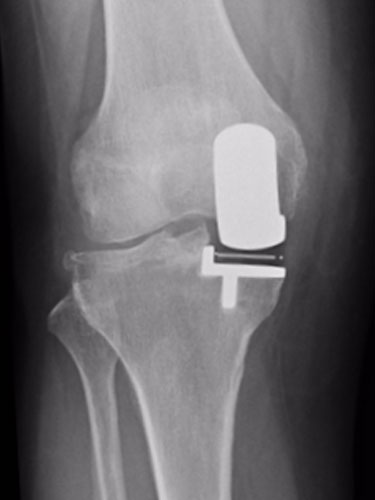Partial knee replacement in the morning, home for dinner
- Overview
- Full article
Authors: Mr Peter Kempshall, Consultant Knee Surgeon, and Dr Leon Visser, Consultant Anaesthetist

Playing tennis, badminton and dancing well into retirement is now considered normal and many people talk instead of "sixty being the new forty". But if you're suffering from knee arthritis, pain may be getting in the way.
Symptoms of knee arthritis
Knee pain is the main feature of knee arthritis. Whilst it can initially be felt following activity, it can progress on to pain during walking which commonly limits your walking distance. When sitting down your knee may not feel too bad, but as soon as you stand on it it hurts. Frequently it hurts more after activity and it's common to get pain in the evening.Your knee can feel stiff and the pain may even wake you at night.
The pain from arthritis comes and goes as part of the condition. Many people experience good and bad phases of a few weeks in length which alternate between relatively little pain and lots of pain.
Once the arthritis damage (osteoarthritis) in your knee is bad enough, it can give you a sense of being unsteady, especially on uneven surfaces, or if you turn around quickly. You might stop trusting your knee and worry that the knee might let you down at the wrong time.
Nobody really wants to have to have an operation, but when the regularity of these bad phases becomes often enough then surgery becomes an acceptable option to many
Options: non surgical treatments
Explaining what single compartment knee arthritis is to people, is sometimes all that is needed for them to be able to modify their lives to be able to cope with their pain. Using things like over the counter painkillers and knee supports are a good first step. An often talked about ‘cortisone’ (steroid) injection may help to relieve the pain for a time. However, repeated injections often get less and less effective.
Dietary supplements and glucosamine can help for some people although it’s still unclear why this works in some and not others. There are other treatments available for early arthritis pain when it is too early for surgery such as visco-supplementation and platelet rich plasma (PRP).
Stem cell injections, derived from the body's own rapidly regenerating fat cells (lipogems), is a treatment option that is largely new and rapidly developing in clinical practice

Options: Partial knee replacement
The partial knee replacement is a resurfacing replacement of just the damaged part of the knee. The undamaged healthy parts are not replaced. Leaving the undamaged sections, improves recovery often to the point where patients actually forget that they’ve even had a partial knee replacement. “The forgotten knee” is the holy grail in the knee surgery world and happens sixty percent more often in partial knee replacement than in total knee replacement.
This is largely due to a partial knee replacement being a shorter, less traumatic procedure that leaves your own healthy cartilage and ligaments alone. It re-aligns your knee back to an anatomically normal position thus removing the unsteady feeling. By correcting the alignment back to normal, walking pattern improves. This normal walking pattern, also known as gait pattern, can ease the pressures on the other aching parts of the body.
Whilst less invasive than a total knee replacement, it is still major surgery and no ‘walk in the park’ for those having it. The initial period of pain following the operation diminishes after the first few days. After this, as the swelling decreases, patients start to walk with a more normal gait as the lower leg is in a normal position again and not bow legged. By six weeks, patients are making progress with rehabilitation, walking normally and increasing the distance every day.
Compared to total knee replacement, the partial knee replacement has a lower risk of complications, less chance of clots and less wound infections. It may allow more knee bend than a total knee replacement and people are more satisfied on satisfaction questionnaires. It has an improved chance of getting you back to doing those things that you love to do.
Who is suitable?
In order to be suitable for a half knee replacement, you will need some x-rays taken when you are standing and with the knee bent, loaded in an active position. For partial knee replacement to succeed, the arthritis needs to be in only one part of your knee, either the inside or the outside, but not both. You will also need to be examined by your surgeon to confirm clinically that your knee straightens fully and that your knee ligaments are functioning normally.
The procedure
The day-case procedure uses a general anaesthetic combined with a state-of-the-art nerve numbing procedure, where only the pain sensation in the leg is numbed and not the muscles. This provides adequate pain relief, yet keeps the muscles working. This means that as soon as patients wake up from their operation they can move, bend, stand and walk on their partial knee replacement.
The surgery itself uses ultra-modern implants, dissolvable sutures and skin superglue with flexible dressings that do not hinder movement or recovery. Cooling the knee plays an important part in the recovery process to reduce the swelling improve pain and helps regain knee bend.

The surgery is scheduled for the morning so you can be back on the ward in time for lunch and commence rehabilitation. Within a few hours after the operation patients can stand with full weight bearing and walk on the knee. By the end of the day, patients are able to put on their own clothes, sit out, walk to the toilet and function normally.
The physiotherapist will work with partial knee replacement patients in the afternoon on the day of surgery to make sure they can manage the stairs and walk with a walking stick if needed, although this is not often. When ready to go home following a partial knee replacement patients will have a bespoke rehabilitation package of physiotherapy.
Last updated Wednesday 27 November 2019
First published on Wednesday 3 April 2019

